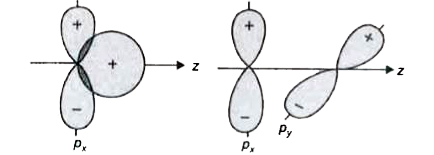The type of overlap given below do not involve in bond formation - Why ?

Text Solution
In gigure I the net overlap becomes zero, since ++ overlap is equal to +− overlap.
In figure II no overlap occurs due to different symmetry.
|
Updated on:21/07/2023
Topper's Solved these Questions
- BOOK - SURA PUBLICATIONCHAPTER - CHEMICAL BONDINGEXERCISE - Evaluate Yourself16videos
CHEMICAL BONDING
- BOOK - SURA PUBLICATIONCHAPTER - CHEMICAL BONDINGEXERCISE - LONG ANSWERS QUESTIONS :13videos
CHEMICAL BONDING
- BOOK - SURA PUBLICATIONCHAPTER - BASIC CONCEPTS OF ORGANIC REACTIONS EXERCISE - CREATIVE QUESTIONS [HOTS]14videos
BASIC CONCEPTS OF ORGANIC REACTIONS
- BOOK - SURA PUBLICATIONCHAPTER - ENVIRONMENTAL CHEMISTRY EXERCISE - 5 MARKS1videos
ENVIRONMENTAL CHEMISTRY
Similar Questions
Knowledge Check
- Question 1 - Select One
Back bonding involves the formation of
AσbondBCoordinate bondCπ bondDNone of these. - Question 2 - Select One
The type of overlapping in Br-F bond in BrF3 molecule is
Asp3−pBsp2−pCsp3d−pDsp3−d2−p - Question 3 - Select One
Which type of overlapping results in the formation of a π bonds
AAxia overlapping of S-S orbitalsBLateral overlapping of p-p orbitalsCAxial overlapping of p-p orbitalsDAxial overlapping of S-P orbitals
Why does type of overlap given in the following figure not result in bond formation?
 View Solution
View SolutionWhy does type of overlap given in the following figure not result in bond formation ?
 View Solution
View SolutionWhy does type of overlap given in the following figure not result in bnd formation ?
 View Solution
View SolutionWhich type of the overlap of orbitals involves in hyberconjugation?
View SolutionWhich type of the overlap of orbitals involves in hyberconjugation?
View Solution


